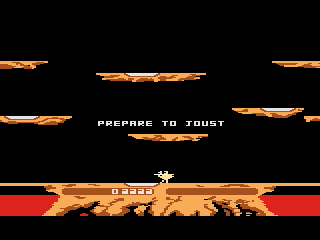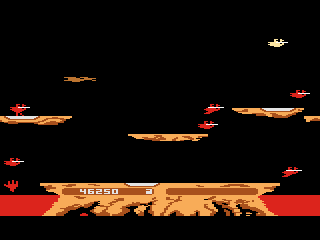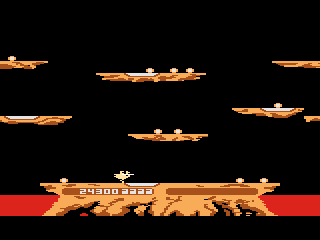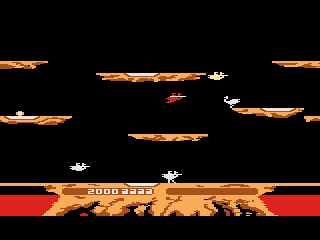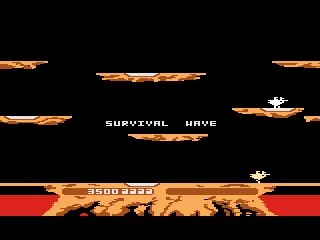|
|
Joust
|
Name:
|
Joust |
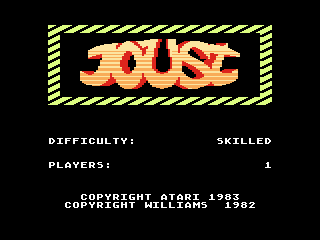 |
| Company: | Atari | |
|
Model #:
|
RX-8044 | |
|
Programmers:
|
Steven Szymanski, Allen
"Alien" Wells, Mike Horowitz, and Pete Gaston (GCC) |
|
| Year: | 1983 | |
|
Released?
|
Yes
|
|
|
Notes:
|
Thy Game Is Over! |
Jousting and ostriches... They go together like peanut butter and jelly. Well maybe not, but they do make for one awesome game. Who ever thought of knights jousting on the backs of ostriches and buzzards needs some serious help. However Joust is just one example of the innovative and highly original games that were commonplace in the 80's (remember when every game wasn't a doom clone?). Joust was so popular that it even spawned a sequel, but sadly Joust 2 was never released for any home system.
As the name implies, this game involves jousting. Actually it's not so much jousting as it is belly flopping on top of the enemy (going lance to lance only results in the enemy and player bouncing back). The trick to unseating the enemy is really to hit him above the lance with the bottom of your ostrich. While this may sound difficult (and it kinda is), it quickly becomes second nature. Speaking of the enemy, let's introduce them now:
| Bounders |
|
These are the guys on the red buzzards. If there was ever a grunt of the Joust world it's the Bounders. Expect to see these guys on just about every level until they finally begin to be replaced with. |
| Hunters |
|
These rather drab looking guys are dressed in all gray and are slightly faster than the Bounders. Hunters are also slightly smarter than Bounders and won't fall into obvious traps as easily (although they still get dragged down by the Lava Troll on a regular basis). |
| Shadow Lord |
|
These blue guys are at the top of the pecking order (pun intended). Both fast and intelligent, Shadow Lords can prove to be a royal pain in the butt if encountered in large numbers. The later waves are full of these guys so watch out. |
When an enemy is hit he'll drop an egg which will hatch after a few seconds (assuming it doesn't land in the lava). When an egg hatches it automatically gets upgraded to the next class of enemy (Bounders hatch into Hunters, and Hunters hatch into Shadow Lords), so be quick about picking them up. Unlike in the 2600 version, the eggs in this version don't fly around the screen and generally only bounce a few inches before coming to a stop.
Starting on the third wave you'll notice that the ledges above the lava at the bottom of the screen disappear. Once this protective layer is gone, flying too close to the lava will result in your bird being grabbed by the Lava Troll. The Laval Troll gets his kicks by pulling your bird (or the enemy) down into the lava, so make sure you fly a healthy distance above. If you happen to get caught by the Lava Troll, quickly press the flap button to break free. If you're good enough you can use the Lava Troll to get rid of some of those pesky buzzards by luring them down towards the lava. However this trick is a risky proposition at best, as it often results in you going under as well.
Starting around wave seven or so you'll begin encountering the Pterodactyl (yes that orange blob IS a pterodactyl). The Pterodactyl is amazingly fast and very deadly, thankfully he only comes out if you take too long to clear a wave (or right away on Pterodactyl waves). Usually the Pterodactyl will slowly cruise the level until he sees the player and then suddenly charge. Unlike the buzzard riders you cannot kill the Pterodactyl by bouncing into him, instead you must carefully hit the tip of the Pterodactyl's beak with your lance. Since both are only about one pixel wide, successfully lining this shot up is nearly impossible. It's best to just avoid the Pterodactyl all together unless you're feeling extremely lucky.
Every now and then a special theme will be announced at the beginning a wave. Depending on the announced theme there will be a chance to earn bonus points by following the instructions (kill/don't kill the other player, grab all the eggs, etc.). Here's a list of the various types of waves encountered in the game.
| Survival Wave (one player) | Player is awarded 3,000 points if he doesn't die during the wave. |
| Team Wave (two player) | Each player is awarded 3,000 points if they don't kill each other during the wave. |
| Gladiator Wave (two player) | The first player to kill the other is awarded 3,000 points. |
| Egg Wave | Every five waves the screen will begin filled with eggs (all ledges are restored as well). Quickly grab all the eggs before they begin to hatch. |
| Pterry Wave | The wave starts out with a pterodactyl on the screen (not good!). |
While Joust is a great one player game, it's considered to be one of the best for two player simultaneous play. Depending on what kind of mood you're in, you can either team up with a friend or try and destroy them. This kind of two player flexibility combine with a great gameplay concept makes Joust one of the best games of all time. Interestingly while the Atari 5200 and 8-Bit ports are nearly identical, the 8-Bit port has a minor tweak that makes it more fun to play. In the 8-bit port the player can move while they're materializing, in the original 5200 version the player had to wait until the process was over to move. This fact and the more response fire button makes the Atari 8-Bit port the superior version.
| Version | Cart Text | Description |
| ?/??/83 | Joust |
Very close to final |

